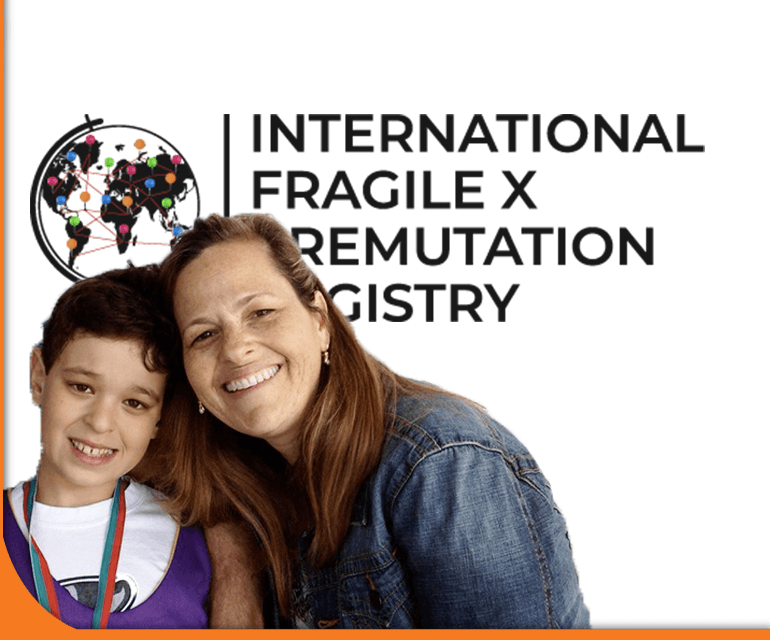Understanding Fragile X & Autism
Individuals with Fragile X syndrome (FXS) are frequently co-diagnosed with autism or autism spectrum disorder, and families and some professionals are often confused by the relationship between the two. Research published over the years has contributed to our understanding of the impact of an autism diagnosis in the care of people with Fragile X syndrome, and whether the link between the two extends beyond behavioral similarities.
Diagnosing Autism
What is Autism?
Autism is a spectrum disorder, which means there’s a wide range of lifelong symptoms that vary in form and severity, but it is generally characterized by an impairment in social interaction and communication, and the presence of restricted and repetitive patterns of behavior, interests, or activities. (Autism spectrum disorder (ASD) | Autism Speaks)
According to the Centers for Disease Control, autism affects an estimated 1 in 36 children and 1 in 45 adults in the United States today. On average, autism is diagnosed around age 5 in the U.S., with signs appearing by age 2 or 3, though many parents and caregivers have shared they noticed signs before their child’s first birthday. By age 2, a diagnosis by an experienced professional can be considered reliable (citation: Autism from 2 to 9 years of age – PubMed (nih.gov)). Autism impacts every sex, age, race and ethnicity. Research from the CDC does show that boys are diagnosed with autism four times more often than girls.
Causes of Autism
There is a strong genetic component to autism. Research suggests almost 20% of younger siblings of a child with autism will receive a diagnosis themselves (citation: Familial Recurrence of Autism: Updates From the Baby Siblings Research Consortium – PubMed (nih.gov)), which is much higher than the CDC-reported 1% to 2% risk among the general population.
Researchers continue trying to determine both the genetic and non-genetic environmental factors that contribute to autism. An estimated 50% of individuals with ASD have a genetic “cause”, including chromosome deletions or duplications, an identifiable syndrome or single gene condition like Fragile X (citation: The Autism Spectrum: Behavioral, Psychiatric and Genetic Associations – PMC (nih.gov) ). There are also certain environmental influences, like advanced parental age, prenatal exposure to some contaminants, maternal factors, and birth complications, that have also been associated with ASD (source: National Institute of Environmental Health Sciences: Autism (nih.gov)).
The Diagnosis
There is no medical test, such as a blood test or brain scan, to diagnose autism. Instead, a developmental or general pediatrician, neurologist, psychologist, psychiatrist, or other specialists, will look at a child’s behavior and development to determine both the diagnosis and its severity. The standard reference used to diagnose mental and behavioral conditions—including autism—is the Diagnostic and Statistical Manual of Mental Disorders (DSM-5). There are also cases where a child does not meet the diagnostic criteria for autism but will have autistic-like features.
To meet diagnostic criteria for ASD according to DSM-5, a child must have persistent deficits in each of three areas of social communication and interaction plus at least two of four types of restricted, repetitive behaviors. Learn more at Clinical Testing and Diagnosis for Autism Spectrum Disorder | Autism Spectrum Disorder (ASD) | CDC
Treating Autism
Early intervention services are important for children from birth to 3 years old and include therapy to help the child interact with others. A parent or caregiver suspecting autism or other developmental problems needs to work with their child’s doctor as soon as possible.
Treatments beyond early intervention fall into the categories of behavior and communication, dietary, medication, and complementary medicine, which may include:
- Auditory training.
- Discrete trial training.
- Vitamin therapy.
- Anti-yeast therapy.
- Facilitated communication.
- Music therapy.
- Occupational therapy.
- Physical therapy.
- Sensory integration.
Learn More
A Blood Test for Autism? Not so Fast
The notion that autism itself can be directly diagnosed through a blood test is incorrect and misleading.
FORWARD Registry & Database
FORWARD is a first-of-its-kind longitudinal database of clinician- and parent-reported data from individuals living with Fragile X syndrome.
Diagnostic and Statistical Manual of Mental Disorders (DSM-5)
From the American Psychiatric Association, publisher of the DSM: Find educational resources, learn of changes, submit feedback, and more.
Be a part of the solution.
Learn more about the INTERNATIONAL FRAGILE X PREMUTATION REGISTRY and join individuals with the premutation and their families to help advance — and encourage — deeper understanding and research into the premutation condition.
Be a part of the solution.
Learn more about the International Fragile X Premutation Registry and join individuals with the premutation and their families to help advance — and encourage — deeper understanding and research into the premutation condition.
Diagnosing Fragile X
The FMR1 DNA Test (sometimes called the Fragile X DNA Test) is the standard of care for determining the presence of Fragile X. DNA testing detects more than 99% of individuals (both males and females) with FXS, as well as those with the Fragile X premutation (commonly referred to as Fragile X premutation carriers.)
Who Should Have Fragile X Testing?
Any male or female with intellectual disabilities, developmental delay, speech and language delay, autism or learning disabilities of unknown cause.
Any female with infertility, elevated FSH levels, premature ovarian failure, primary ovarian insufficiency, or irregular menses. Learn more.
Any male or female over 50 with features of FXTAS, including intention tremors, ataxia, memory loss, cognitive decline, or personality change, especially in combination with a positive family history of Fragile X.
Any preconception or pregnant female who expresses interest in or requests Fragile X carrier testing.
Learn more about Fragile X Testing. To locate a genetic counselor in your area, visit the National
Society of Genetic Counselors, or contact the National Fragile X Foundation:
treatment@fragilex.org | (800) 688-8765.
Who Should Have Fragile X Testing?
Any male or female with intellectual disabilities, developmental delay, speech and language delay, autism or learning disabilities of unknown cause.
Any female with infertility, elevated FSH levels, premature ovarian failure, primary ovarian insufficiency, or irregular menses. Learn more.
Any male or female over 50 with features of FXTAS, including intention tremors, ataxia, memory loss, cognitive decline, or personality change, especially in combination with a positive family history of Fragile X.
Any preconception or pregnant female who expresses interest in or requests Fragile X carrier testing.
Learn more about Fragile X Testing. To locate a genetic counselor in your area, visit the National Society of Genetic Counselors, or contact the National Fragile X Foundation: treatment@fragilex.org | (800) 688-8765.
Treating FXS
There are many areas of treatment and intervention that can improve the lives of affected individuals and their families. Given the proper education, therapy, and support, all persons with Fragile X syndrome can make progress.
While some strategies used to support individuals with autism may work for individuals with Fragile X, some may not. Traditional strategies for behavioral issues in children are less effective for decreasing inappropriate behaviors in individuals with Fragile X syndrome. Instead, a behavior plan that is “front-loaded” with antecedent strategies is recommended so that the person with Fragile X syndrome is supported and set up to engage in appropriate behaviors.
General treatment recommendations are centered around speech and language, feeding, anxiety (including social anxiety), hyperarousal, sensory sensitivities, ADHD, aggression, and self-injurious behaviors.
Interventions designed by a team with specific knowledge of the behavioral, learning, medical, and physiological characteristics associated with Fragile X syndrome are usually helpful in reducing challenging behaviors. Along with a proactive approach and appropriate accommodations, a solid intervention plan will likely foster positive outcomes and set up the child or adult for success.
Learn More
Treatment & Intervention
Full list of consensus and evidence-based treatment recommendations from the NFXF’s Fragile X Clinical & Research Consortium
Behavioral Challenges in Fragile X Syndrome
Consensus document for behavior from the Fragile X Clinical and Research Consortium.
Fragile X Clinics
Fragile X clinics provide individuals and families affected by a Fragile X conditions with comprehensive evaluation and treatment recommendations.
FXS+ASD
Among the genetic causes of autism, Fragile X syndrome — one of the more than 800 genes associated with autism — is the most common, known inherited single-gene disorder, and accounts for an estimated 1% to 6% of all autism cases, and according to the CDC, a national parent survey found that 46% of males and 16% of females with Fragile X syndrome have been diagnosed or treated for autism.
According to the CDC, a national parent survey found that 46% of males and 16% of females with FXS have been diagnosed or treated for ASD.
Testing for Known Genetic Causes of Autism
Though blood tests are not part of an autism diagnosis, they come into play to rule out known genetic causes of autism. Having a genetic diagnosis in addition to an ASD diagnosis can help families in several ways—including understanding the supports and treatments that may be most helpful.
Autism and Fragile X syndrome are often diagnosed separately, with many children diagnosed with autism before they are diagnosed with Fragile X syndrome.
The American Academy of Pediatrics recommends anyone with a developmental delay, intellectual disability or autism diagnosis have the Fragile X DNA (genetic) test. It is important to receive the Fragile X-specific test, as Fragile X will not be found by microarray or exome sequencing. .
While FXS is the most common single gene link to autism, they are not the same thing and should not be treated as the same thing. For example, an impairment in social interaction is one of the core characterizations of autism. But since many children with Fragile X syndrome are interested in social interactions, treatments for autism that focus on the social aspect, may not be productive in the overall care for those with FXS+ASD. It is important to look at the individual and consider all associated diagnoses when making a plan for their care.
Treating FXS+ASD
Challenging behaviors that are seen in a higher proportion of children with FXS+ASD vs. those with Fragile X syndrome alone. These behaviors may include attention problems, hyperactivity and impulsivity, anxiety, and aggressive and self-injurious behaviors.
Many individuals with FXS utilize behavioral therapy, but medication can sometimes also be helpful to support speech-language, occupational, and educational therapeutic services, and to allow a child to learn in the least restrictive environment.
More intensive speech/language therapy, with an emphasis on group sessions, behavioral therapy, and augmentative technology are often indicated for FXS+ASD. Young children should also have intensive therapeutic intervention through early intervention programs. Educational strategies may need to include as much focus on daily living skills as on academics.
Learn More
Autism Spectrum Disorder in Fragile X Syndrome: Cooccurring Conditions and Current Treatment
This study examines the impact of the autism diagnosis in a large clinic-based Fragile X syndrome population to better inform the care of people with Fragile X syndrome. (Pediatrics, June 2017, Vol. 139)
FXS and ASD: Similar But Different
Clinical perspectives on the behavioral differences between Fragile X syndrome and what are thought to be core features of autism.
Fragile X Syndrome Testing & Diagnosis
DNA testing detects more than 99% of individuals (both males and females) with FXS, as well as Fragile X carriers.
The Who, What & How for Genetic Counseling
Who should seek counseling? What does a genetic counselor do? How do I find one?
Also See:
Find a Genetic Counselor (National Society of Genetic Counselors)
Similarities & Differences
FXS vs. ASD
Characteristics that have been found to differ between the behavioral presentation of Fragile X syndrome and autism include:
- The frequency of intellectual disability is higher in Fragile X syndrome than in autism. Most males and about a third of females with Fragile X syndrome have intellectual disability, while only about 40% of individuals with autism have intellectual disability.
- Motor coordination deficits are worse in Fragile X syndrome than autism.
- Individuals with autism are more likely to show worse receptive language than expressive language, while individuals with Fragile X syndrome tend to show the opposite pattern.
- Interest in socializing is higher in Fragile X syndrome in general than autism (although limited by anxiety and avoidance).
- Imitation skills are better in Fragile X syndrome than autism when level of intellectual impairment is controlled.
FXS+ASD vs. FXS Alone
Characteristics of individuals with Fragile X syndrome who meet criteria for autism (FXS+ASD) compared to individuals with Fragile X syndrome alone include:
- Less developed language skills, particularly receptive skills.
- Lower non-verbal cognition and IQ scores.
- Lower adaptive skills.
- More severe overall behavioral problems.
- Reduced interest in and motivation for social interaction or a failure to attend to social information that might promote appropriate social behavior.
Individuals with FXS+ASD may face similar but more severe challenges than children with Fragile X syndrome.
Learn More
Making Sense of Multiple Diagnoses
When it comes to diagnosing Fragile X syndrome, there is good news and bad news. The good news is that more children than ever are being accurately diagnosed with Fragile X syndrome at an early age. The bad news is that there is a lot of confusion among parents, and even professionals, about the meaning of Fragile X in relation to other types of diagnoses that a child receives.
Clinical Insights into the Similarities and Differences for Diagnosis and Treatment
The two conditions may have considerably more overlap than previously thought.
A Complex & Evolving Relationship
The relationship between Fragile X syndrome and autism is complex and constantly evolving. Despite the frequency and severity of autism in Fragile X syndrome, there are still important gaps in knowledge.
For further reading on the relationship between autism and Fragile X syndrome, see DELETE link and replace with Fragile X Syndrome Related Concerns on the CDC website, and related treatment recommendations and articles below.
Learn More
FXCRC Consensus Document “Autism Spectrum Disorder in Fragile X Syndrome”
This document clarifies how the autism diagnosis and Fragile X syndrome can overlap, and where they do not.





